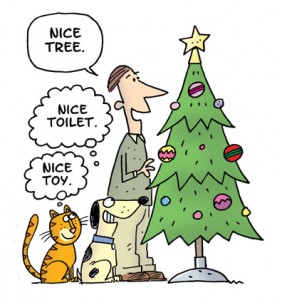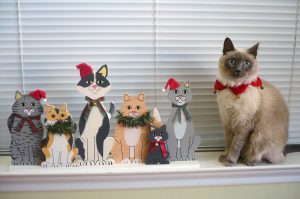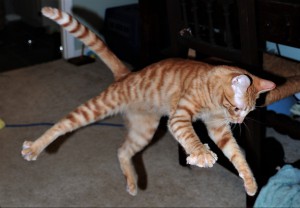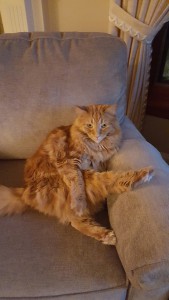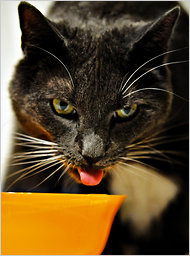MyThreeCats.com was named an expert in a Rent.com article. Check out the featured article: 4 Tips For Choosing Cat-Friendly Holiday Decorations| Rent.
Rent is a subsidiary of Redfin.com
Category: feline health
Have a Merry Little Cat-Friendly Holiday!
November 3, 2024
I don’t know about you, but I am starting to get excited thinking about decorating for the holidays! Pets and holidays can be harmonious with a little thoughtful, advance planning.
Live versus Fake Christmas Trees
One thing that never occurred to me was how deadly my live holiday tree potentially was to my cats and dogs. Once I realized this, the fake tree won hands down. While the pine fragrance of a live tree is lovely, pine needles are mildly toxic and downright dangerous if ingested. Real trees are also preserved with toxic chemicals that make their standing water dangerous to pets.
Avoid These Plants:
Other potentially risky décor items you should avoid in a pet household are toxic plants such as yew, ivy, holly, mistletoe, and poinsettia. It’s better to not have them around as a chewing temptation for feline and canine family members.
Nix These Décor Items:
Tinsel and low hanging glass ornaments are major hazards for cats and dogs. Tinsel can cause choking and injury if swallowed. Glass ornaments can be easily swatted and broken, causing injury. Choose wooden, plastic or non-breakable ornaments to decorate your tree.
Thankfully, the internet is filled with lots of excellent pet care resources so we can learn all these important safety tips before anybody gets hurt. No one wants a last-minute emergency trip to the vet!
Invest in Your Cat’s Safety:
Always provide your pets with their favorite toys to divert their attention away from holiday decorations and to keep them occupied and safe. Cats love catnip, silvervine and honeysuckle-filled grab toys, teaser toys to chase and treat puzzles to satiate curious minds. Providing them with their own cat tree to climb and scratch will likewise distract them from your holiday tree.
Dedicate a space in your home exclusively for your cats to enjoy while the guests are partying. You will find it is a great solution to help keep your furballs happy and secure. Set up their food and water bowls, litter boxes and toys, as well as a cozy bed or blanket for napping.
Have a purr-fect holiday season!
Unleash Your Indoor Cat’s “inner kitten” With These Easy Tips
Cats are intelligent, active creatures that need daily stimulation just as we do. Helping your cats tackle boredom can keep unwelcome behaviors to a minimum.
Constant, compelling meows, scratching furniture, and urinating outside the litter box may be symptoms of medical issues that should be treated by a veterinarian. In healthy cats, those behaviors can be avoided by keeping your feline companions entertained throughout the day.
Try these solutions:
- Here’s a simple way to entertain your cats for hours at a time. Place a sturdy, multiple-tiered cat tree with a good scratching surface such as sisal next to a window with an exciting view! They’ll ogle at birds, passing cars, and anyone walking by.
- Before you leave your cat home alone, turn on calming music or nature sounds to soothe and comfort him. Go a step further to delight your furbaby by finding a compelling video for him to watch on “Cat TV”, a television channel created specifically for cats.
- If you have empty wall space, quench your cat’s need to climb by installing perch wall units which create safe pathways for him to launch to tops of bookshelves and other high places.
- Indulge the natural hunting instincts in your cat by hiding treats or dry kibble in your home. Use a kitty food puzzle that will provide your cats with a stimulating activity. The challenging activity appeals to the natural love of hunting and will stimulate them both mentally and physically. Change the locations frequently to keep things interesting and encourage your kitty to embrace his inner stalker!
- Shake things up by surprising your cat with new toys to sniff, play with, and explore. Catnip toys, puzzle toys, teaser toys and tunnels all make wise investments that will go a long way toward keeping your cat healthy and happy.
- Introduce your indoor cats to one of many attractive models of secure cat enclosures for the yard. They allow your kitties to enjoy some of the perks of being outdoors without any of the risks! Enclosures that can be folded up for easy travel are a bonus!
- Treat your cats to quality one-on-one playtime and cuddle time as often as possible. It is as good for you as it is for them!
Since your cats have a distinct personality just like you do, experiment with several of these entertainment options, then pick and stick to the ones they like best! You’re sure to find just the right options for your cat at MyThreeCats.com.
5 Tips for Keeping Your Cat-Occupied Home Smelling Fresh
Sharing your home with cats has many benefits but one of the downsides is that owning cats also means owning the odors that come along with them.
The irony of course is that cats themselves don’t smell! In fact, they are fastidious about cleanliness. The “smell” people associate with cats is usually because the humans aren’t doing their part to keep things clean.
Bacteria are usually the source of smells, so focus on areas where these bacteria breed and grow and you can catch odor early before it gets bad.
Here are 5 ways to keep your home fresh, whether you have one cat or a whole gang of them.
- Start With The Litter Box
Not surprisingly, litter box smell can be overpowering and permeate your entire home if left unattended. Make sure you are scooping litter boxes at least once a day and more often if you can. Then, get that waste out of the house quickly!
Consider sprinkling a bit of baking soda in the bags you use to collect the litter box contents. This might help keep the odors in check in your outdoor garbage until garbage day. Another great use for baking soda is to sprinkle some at the bottom of the litter box to help absorb odors.
Even if you’re scooping regularly, make sure to change the litter completely a couple of times a month because bacteria remain in the box even after you scoop. Wash out the box with unscented soap and water each time you change the litter and remember to replace the entire box once or twice a year.
Finally, consider investing in a smart, stylish litter box that contains the odor and blends in with any décor.
- Investigate the Entire House For Smells
If you can’t easily determine the source of an odor in your home, do some detective work to find out if your cat’s doing his business outside the box. Check corners, behind furniture and in closets to find out if your cat’s been peeing or pooping where he shouldn’t.
Also check along walls and the walls themselves to determine if you have a spraying cat. If your cat has been using a spot in your home as his alternative potty spot, use an enzymatic cleaner to clean the area or items or, ideally, throw them away.
Also, it’s important to remember that if your cat is peeing or pooping in strange places, please schedule a vet visit. Sometimes this type of behavior is a symptom of a medical issue.
- Get the Vacuum Out
If you have cats or any type of pet, be diligent about vacuuming. And don’t stop with the carpet. Make sure you regularly vacuum rugs, couches, chairs and even draperies to capture fur, dander and, yes, odors. Again, sprinkling baking soda on carpets or furniture and then vacuuming it up can help keep things fresh.
- Wash Cat Beds and Blankets
Don’t forget to clean your cat’s favorite blankets or cat bed on a regular basis. Choose beds that can be cleaned and easily maintained. Remember, your cat’s paws dig in the litter box several times a day. There’s bound to be some transfer of germs and odor-causing bacteria. Keep those snuggle spots clean!
- Keep Food and Water Area Clean
Your cat’s food and water areas are another prime breeding ground for bacteria. Sitting water, like the water in your cat’s bowl, can quickly grow bacteria, eventually leading to an unpleasant smell. And, you certainly don’t want your cat drinking out of it! Wash the water bowls and replace with clean water at least once a day. Choose non-porous bowls that can easily be cleaned and maintained.
Food that sits out can also lead to a smelly mess. Make sure to clean up spilled kibble and especially chunks of uneaten canned food that your cat may have missed.
Just because you have cats in your home doesn’t mean it has to smell like you have cats in your home! Keep on top of regular cleaning and be aware of stinky trouble zones, and you’ll have a fresh clean house for everyone in your family to enjoy!
Do you have a tip to share us with us? How do you keep your cat-occupied home smelling fresh? Let’s chat about it in comments below!
Bottoms Up! 9 Ways to Get Your Cat To Drink More Water
We all benefit from drinking more water and your cat is no exception.
Good urinary health is associated with drinking plenty of water for both humans and cats. Good hydration contributes to good digestive health, healthy skin and coat, and more.
Cats who don’t drink enough water are at risk of developing urinary tract issues like infections, urinary stones or, with some male cats…a blocked urethra.
The challenge is most cats don’t drink enough water because they’re just not that thirsty! Canned cat food is almost 80 percent water, so cats who eat it daily are getting the hydration they need from food.
- Like a horse, you can lead a cat to water, but you cannot make him drink! You can make water more alluring to your favorite feline by trying the following strategies Ice it down! Place a couple of ice cubes into your cat’s food to add moisture. Some cats consider them a little treat! The ice ends up tasting like the food in the bowl, and while your cat licks the tasty cube, he’s getting extra water.
- Add some ice cubes in your cat’s water to make it more interesting, too. Don’t be surprised if your cat starts to prefer icy cold water.
- Make sure there is fresh water in your cat’s favorite bowls throughout the house, or at least in the rooms where he spends most of his time. Use several of your cat’s favorite containers. The best bowls for cat food and water are made of nonporous materials that don’t trap bacteria. A cat’s whiskers are ultra-sensitive, so shallow, wide bowls make for kitty’s most comfortable mealtimes and encourage him to linger longer and drink more water. Check out the attractive assortment of modern bowls, feeding mats and fountains at MyThreeCats.com.
- Change the water and wash the bowls and cups often. You wouldn’t want to drink from a glass full of water that’s been sitting around for a few days; neither would your cat!
- A little chicken broth or tuna juice might spice up kitty’s drinking experience. Add a bit to the water and see if she likes it.
- Try a cat fountain! Fountains that provide clean, flowing water capture a cat’s interest. And, while it might take a couple of days for cats to get comfortable with a fountain, most like and even learn to prefer them. One of our favorite fountains is this ceramic option that can be enjoyed by multiple cats.
- Including a high portion of high quality canned food in your cat’s daily diet is the easiest way to get more moisture into your cat’s diet. Better yet, most cats love it!
- If an all-canned-food diet isn’t in your budget or your cat doesn’t take to it, try adding a bit of water or low-sodium chicken broth to his dry food for moisture content.
- If you can, feed your cat more frequent, but smaller, meals. Eating usually encourages thirst so eating more often may get him to drink a little more, a lot more often.
Water intake is one of the most critical elements to good feline health, so make sure your kitties always have plenty of tempting opportunities to whet their whiskers!
Have you had success with other strategies to get your cat to drink more water? Share them with us in a comment below!
